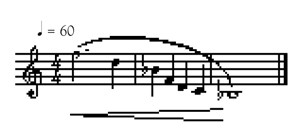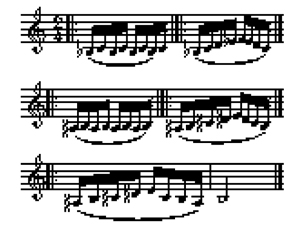.jpg) Although there is a substantial amount of material available for brass warmups, ranging from lip slurs to pedal tones, there are fewer options for saxophone. While warming up, saxophonists should focus primarily on tone. This can be quickly forgotten in beginning band when brass players are struggling to play the correct partial, but playing with a pure sound requires training that can be generated from the warm up.
Although there is a substantial amount of material available for brass warmups, ranging from lip slurs to pedal tones, there are fewer options for saxophone. While warming up, saxophonists should focus primarily on tone. This can be quickly forgotten in beginning band when brass players are struggling to play the correct partial, but playing with a pure sound requires training that can be generated from the warm up.
Warmups are also an excellent way to get students familiar with the fingerings of the extreme high and low register. The best way to work on this is with a slurred descending triad pattern, played slowly. Starting in the key of Bb major, have the student play an F5 for three beats. Then on descending quarter notes move to D, middle Bb, F4, then low D, C, and ending on a low Bb held for four beats. The exercise should be played in every key, ascending a half step each time, until the staring note is high F#6. The exercise can be played with either a straight tone or vibrato, depending on the ability level of the student.

This same exercise can be expanded to incorporate intonation into the warm up. Once the exercise has been learned in all keys and registers, a drone can be added. Drone references can either be purchased commercially or recorded with a synthesizer. Some tuners also produce drones. For example, the first descending exercise begins on a written F; when played on an Eb saxophone it should be paired with a drone on concert Db. Each note of the exercise, which includes the fifth, third, and root of a Db chord, should be held until it is in tune with the drone.
Another component of a sound saxophone warmup is work on manipulating pitch. A good way to practice this is to have students play only the mouthpiece. An alto saxophone mouthpiece should produce a concert A. Any pitch either drastically higher or lower than this shows that the embouchure is either too loose or too tight. After students can play the correct pitch, they should begin to explore bending the pitch up or down by half and whole steps, slowly increasing the interval in either direction, with the goal of a one octave range on the mouthpiece.
When students can do this, mouthpiece playing can be regularly included in the warmup. Have students play the first three scale degrees of any key on the mouthpiece. Eventually this can be expanded to the first five scale degrees, and an entire scale if possible, always using a pitch reference such as a piano. More advanced students can work on major, minor, augmented, and diminished scales and triads by playing only the mouthpiece. Also, familiar tunes and folk songs can be used as exercises to expand the student’s abilities on the mouthpiece.
Overtones are a third aspect of a good saxophone warm up. Much like brass instruments, saxophones can also produce multiple partials in the overtone series. This is possible through voicing, a concept that allows saxophonists to play various pitches with one fingering. Saxophone overtones are effective when produced using low Bb through E. Low Bb is the best note to start on; without changing the fingering or adding the octave key, students should be able to produce the note an octave higher. Beyond this a fifth higher and then an additional octave can also be produced. When a student has mastered the ability to produce these notes in the overtones series, without any physical change to the appearance of the embouchure, the range of the exercise can be expanded to high D, high F, and then the altissimo register.
The benefits of incorporating overtones into the warmup process are numerous. By playing the fundamental of the series, low Bb through D, the saxophonist is practicing long tones in the low register. Furthermore, they are practicing the articulation of these low notes numerous times. Student should not move to the next overtone until they are able to attack the fundamental cleanly.
Overtones can also be used as a tone matching exercise. An overtone produced on the saxophone will sound purer than that same note played with the traditional fingering because the overtone is played with an entirely closed tube. Saxophonists can practice making the pitch of the traditionally fingered note as pure as the overtone. For example, the first overtone above the fundamental of a low Bb is a written Bb4. Students should play the first overtone of Bb, and then reattack the same pitch using the traditional fingering for Bb4. This exercise should be repeated until the discrepancies in tone of the two types of fingerings are minimized.
This can be expanded to playing major scales with overtones. A Bb major scale could be produced by playing the first overtone of low Bb through Eb and then producing F through A with the second overtones of low Bb, C, and D, ending with the third overtone of low Bb.
Using overtones in warmups will also expand students’ range. Slowly, if played daily, students will begin to develop an altissimo range, which is called for quite frequently in solo saxophone works.
The final component of a sound saxophone warm up is exercises to facilitate finger coordination. The first way to improve this aspect of playing is with the manipulation of a five note scale. This exercise, a variant of Marcel Moyse’s flute scale patterns, is also known to some as Twiddles. This exercise is extremely effective in improving finger coordination in three difficult areas of the instrument: the low register spatula, the break between C5 and D5, and the palm keys. The exercise is played at a moderate tempo and begins by playing four beats of sixteenth notes between the first and second scale degrees of a key, which would be low Bb and C in the case of the first exercise in the pattern. On the fifth beat the student should change to an ascending and descending five note scale in the same key. After four beats of this, the student then modulates one half step, in time, to B major by playing sixteenth notes alternating from low A# (Bb) to B, and continuing the pattern as before, only the five note scale now ascending to the fourth scale degree, E, as the starting pitch of the five note scale is now the seventh scale degree, A#. The exercise can be ended with a descending, melodic pattern of scale degrees four, two, one, seven, one.

When this is played starting on the low spatula keys, it increases the student’s left hand pinky coordination. When started on a C5, it allows students to focus on keeping the tone quality consistent while moving between C and D. Furthermore, the exercise can be played starting on any of the high palm key notes and will increase coordination between right and left hands in that register as well.
Structured daily warmups for saxophonists, consisting of work on tone quality, intonation, and technique, are just as essential as those brass players do. Be sure to keep the focus on sound quality even when working on technique; in the words of saxophone pedagogue Larry Teal, every study is a tone study.






